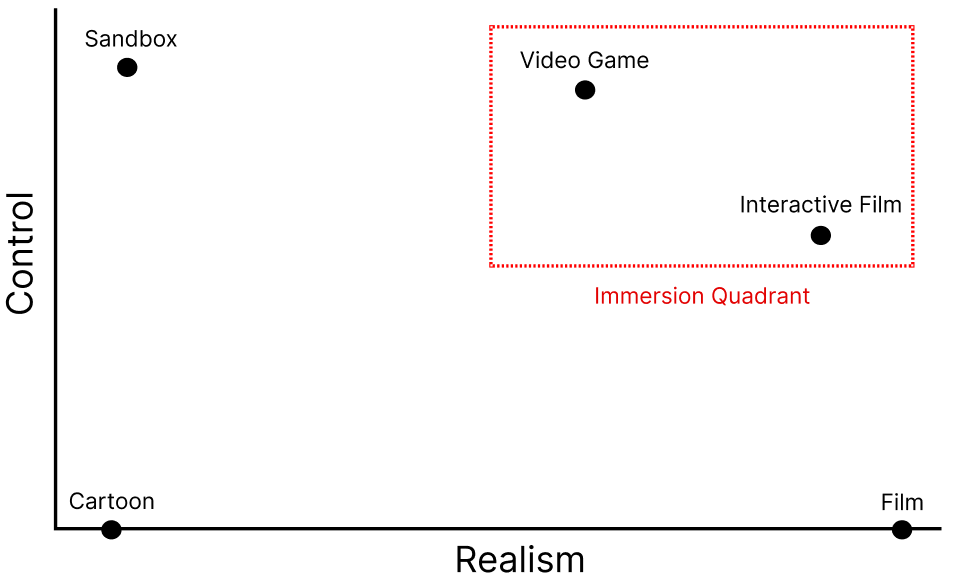In part one, I explore the history of interactive film and the early attempts to give audiences control while sacrificing a smooth and realistic experience.
Let’s examine the space between the level of control and realism. I don’t imply that a medium adheres strictly to the laws of physics when speaking of realism. It’s a measure of how effectively it immerses the player. By control, I refer to the frequency and extent to which the player can intervene, make choices, or influence the internal reality.
When a medium provides too much control, it resembles a sandbox—a simulation environment without inner pace. If it extends for a prolonged period without interactive elements, it resembles a conventional film.
Similar to video games, interactive films aim for the intersection of sufficient realism and a satisfying level of control, balancing immersion and the film experience in, as I tend to call it, the Immersion Quadrant.
Would you argue that a movie, however interactive, should always offer a film experience independently, even if the choices are made automatically or randomly?
Realism: The Essence of Immersion
The sole point behind realism is to create an experience tricking your brain into generating a response as if you were truly there—whether on a battlefield or in a bar! The goal is to bring your brain as close to reality as possible and keep you there. To squeeze the neurotransmitters out through a well-mixed cocktail of sensory stimuli. Sometimes, the brain response can be so intense that it leads to addiction.1
One of the best-known games of the Immersion Quadrant is Heavy Rain (2010), thanks to its thick narrative, use of actual movie footage to place the story into real events, the player’s quick choices throughout the gameplay, and multiple endings.
As a dedicated gamer, I learned about various approaches to immersion from multiple perspectives. Being a game developer helped me gain even deeper insight into these mechanics, and this combination will always keep my internal passion for interactive experiences burning.
The rabbit hole goes even deeper when it comes to immersion in today’s video games. The braindance feature in Cyberpunk 2077 (2020) allows players to relive someone else’s memories in a simulated recording of their own experience.
Soon, computer graphics will achieve a level of realism that, when combined with VR2, will make our physical reality undistinguishable from the virtual one. At that point, it will be easy to fully blend interactive film and video game experiences and maximize the immersion. We surely have a lot to look forward to (and also to be afraid of3).
Player: The Vehicle of Control
Another key point of immersion is creating the player’s identity. Control in an interactive film must be limited and channeled into an avatar, a character, or some other level of identity—not just to embody a person but to make it serve as a vehicle for the action. It can be either first-person or third-person style.
Sure, it would be sweet to have control over an entire movie reality, where your real-time interactions with objects shape the unfolding story. You could throw a banana skin into the scene to make someone slip, watching the consequences play out. But who would you be in this scenario? Your role and identity might blur, leaving the experience feeling less like a story and more like an experiment in control.
The most common design for an interactive film is simply trying to convince you that you embody the main character and control it through a limited series of predefined points on the timeline. You role-play and take over the decisions. As in a video game, there are moments where you don’t control the character, and it somehow exercises free will with the story’s natural flow. That’s when your hero says something you’d never say, takes a shot of vodka you’d never drink, or shoots people you don’t even know.
Let’s make you a hero then. Everybody likes heroes!
In Interande, you occasionally take first-person control of Petr, a 2011 dating master wannabe from the Czech Republic. You two share dating weaponry and embark on a quest to convince Dana that you are the future in her simulated life.
The Immersion Quadrant
We already know you must embody the player into an avatar in an immersive way that provides enough control. After all, it’s all about entertainment, but to determine the right level of decision-making granularity, you balance many variable elements.
You must consider the technical capabilities, filmmaking skills, screenplay consistency, movie player capabilities, and depth and complexity of the experience you want to provide. This brings limitations. To get the most out of your interactive film, you must discretize the interactivity to a frame level.
We were building Interande as a prototype to prove the concept and validate the overall potential, so we couldn’t bite off more than we could chew back in 2011. I have always thought of a perfectly rendered game that smoothly switches between movie footage and controllable game back and forth in real-time without the player noticing the difference, but we were nowhere near that far. We had to use the classic way of filming the entire movie material, post-processing it, gamifying it, and then gluing it all together while sacrificing a lot of control potential and smoothness to set up the strings for the player to pull.
Our concept was interactivity on this level:
It’s nothing spectacular, especially not today. However, we did not foresee the many challenges upfront, even when we gave the player control of just a single character on a 15-minute journey. One of the pieces turned out to be the special video player we had to develop to power the movie. Don’t forget to subscribe if you’re curious about how it’s built and what challenges we had to overcome.
Thank you for reading!
https://pmc.ncbi.nlm.nih.gov/articles/PMC10065366/
Virtual Reality
https://www.technologyreview.com/2024/04/25/1091772/new-generative-ai-avatar-deepfake-synthesia/







